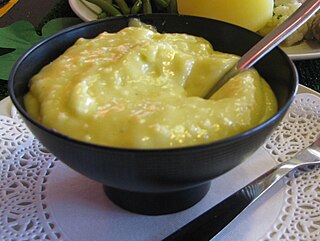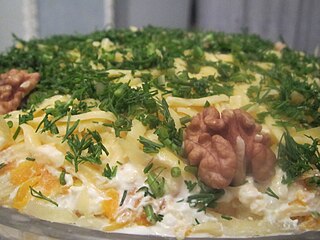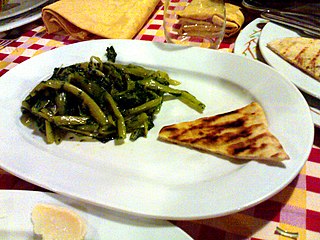
Aioli, allioli, or aïoli is a cold sauce consisting of an emulsion of garlic and olive oil; it is found in the cuisines of the northwest Mediterranean.

Brazilian cuisine is the set of cooking practices and traditions of Brazil, and is characterized by European, Amerindian, African, and Asian influences. It varies greatly by region, reflecting the country's mix of native and immigrant populations, and its continental size as well. This has created a national cuisine marked by the preservation of regional differences.

Egg salad is a dish consisting of chopped hard-boiled or scrambled eggs, mustard, and mayonnaise, and vegetables often including other ingredients such as celery.

An open sandwich, also known as an open-face/open-faced sandwich, bread baser, bread platter or tartine, consists of a slice of bread or toast with one or more food items on top. It has half the number of slices of bread compared to a typical closed sandwich.

Pesaro is a comune (municipality) in the Italian region of Marche, capital of the province of Pesaro and Urbino, on the Adriatic Sea. According to the 2011 census, its population was 95,011, making it the second most populous city in the Marche, after Ancona. Pesaro was dubbed the "Cycling City" by the Italian environmentalist association Legambiente in recognition of its extensive network of bicycle paths and promotion of cycling. It is also known as "City of Music", for it is the birthplace of the composer Gioachino Rossini. In 2015 the Italian Government applied for Pesaro to be declared a "Creative City" in UNESCO's World Heritage Sites. In 2017 Pesaro received the European City of Sport award together with Aosta, Cagliari and Vicenza.

Deviled eggs, also known as stuffed eggs, curried eggs or dressed eggs, are hard-boiled eggs that have been peeled, cut in half, with the yolk scooped out and then refilled having been mixed with other ingredients such as mayonnaise, mustard and sprinkled with paprika, cinnamon or curry powder. They are generally served cold as a side dish, appetizer or a main course during gatherings or parties. The dish's origin can be seen in recipes for boiled, seasoned eggs as far back as ancient Rome, where they were traditionally served as a first course. The dish is popular in Europe, North America and Australia.

Smørrebrød, smørbrød "butter bread" (Norwegian), or smörgås " butter goose" (Swedish), is a traditional open-faced sandwich in the cuisines of Denmark, Norway and Sweden that usually consists of a piece of buttered rye bread, topped with commercial or homemade cold cuts, pieces of meat or fish, cheese or spreads, and garnishes.

In many European countries, particularly in Central and Eastern Europe, there are various traditions surrounding the use of bread during the Easter holidays. Traditionally the practice of eating Easter bread or sweetened "communion" bread traces its origin back to Byzantium, Eastern Catholicism and the Orthodox Christian church. The recipe for sweetened or "honey-leavened" bread may date back as far as the Homeric Greek period based on anecdotal evidence from classical texts.

Uruguayan cuisine is a fusion of cuisines from several European countries, especially of Mediterranean foods from Spain, Italy, Portugal and France. Other influences on the cuisine resulted from immigration from countries such as Germany and Scotland. Uruguayan gastronomy is a result of immigration, rather than local Amerindian cuisine, because of late-19th and early 20th century immigration waves of, mostly, Italians. Spanish influences are abundant: desserts like churros, flan, ensaimadas yoo (Catalan sweet bread), and alfajores were all brought from Spain. There are also various kinds of stews known as guisos or estofados, arroces, and fabada. All of the guisos and traditional pucheros (stews) are also of Spanish origin. Uruguayan preparations of fish, such as dried salt cod (bacalao), calamari, and octopus, originate from the Basque and Galician regions, and also Portugal. Due to its strong Italian tradition, all of the famous Italian pasta dishes are present in Uruguay including ravioli, lasagne, tortellini, fettuccine, and the traditional gnocchi. Although the pasta can be served with many sauces, there is one special sauce that was created by Uruguayans. Caruso sauce is a pasta sauce made from double cream, meat, onions, ham and mushrooms. It is very popular with sorrentinos and agnolotti. Additionally, there is Germanic influence in Uruguayan cuisine as well, particularly in sweet dishes. The pastries known as bizcochos are Germanic in origin: croissants, known as medialunas, are the most popular of these, and can be found in two varieties: butter- and lard-based. Also German in origin are the Berlinese known as bolas de fraile, and the rolls called piononos. The Biscochos were re-christened with local names given the difficult German phonology, and usually Uruguayanized by the addition of a dulce de leche filling. Even dishes like chucrut (sauerkraut) have also made it into mainstream Uruguayan dishes.

A tuna fish sandwich, known outside the United States as a tuna salad sandwich or a tuna sandwich, is a sandwich made from canned tuna—usually made into a tuna salad by adding mayonnaise, and sometimes other ingredients such as celery or onion—as well as other common fruits and vegetables used to flavour sandwiches. It is commonly served on sliced bread.

Cappon magro is an elaborate Genoese salad of seafood and vegetables over hardtack arranged into a decorative pyramid and dressed with a rich sauce.

A meatball is ground meat (mince) rolled into a ball, sometimes along with other ingredients, such as bread crumbs, minced onion, eggs, butter, and seasoning. Meatballs are cooked by frying, baking, steaming, or braising in sauce. There are many types of meatballs using different types of meats and spices. The term is sometimes extended to meatless versions based on legumes, vegetables, mushrooms, fish or other seafood.

Regional street food is street food that has commonalities within a region or culture.

Olivier salad is a traditional salad dish of Russian cuisine. Its creation is generally attributed to Lucien Olivier.

The cuisine of St. Louis is largely influenced by the city’s German, Irish, Italian, Mexican, Chinese, and Vietnamese immigrant population and African Americans who migrated from the Southern United States.

Mimosa salad is a festive salad, of which the main ingredients are cheese, eggs, canned fish, onion, and mayonnaise. Mimosa salad got its name because of its resemblance to mimosa flowers scattered on the snow. The similarity is achieved by crumbling and scattering boiled egg yolk on the surface. The salad's popularity in the USSR has led to the emergence of a wide variety of recipes.

Kewpie—often misspelled kyūpī (キューピー) according to the pronunciation—is a Japanese brand of mayonnaise, and the name of the company that makes it. Kewpie is the best selling mayonnaise in Japan, and is also sold in other countries.

Crescia is a thin Italian flatbread typically prepared in Marche and Umbria. The crescia probably has a common ancestry to the piadina, to be found in the bread used by the Byzantine army, stationed for centuries in Romagna, in the north of the Marche (Pentapolis), and in the Umbrian Valley crossed by the Via Flaminia. The food is also known by the common name of "white pizza".


















